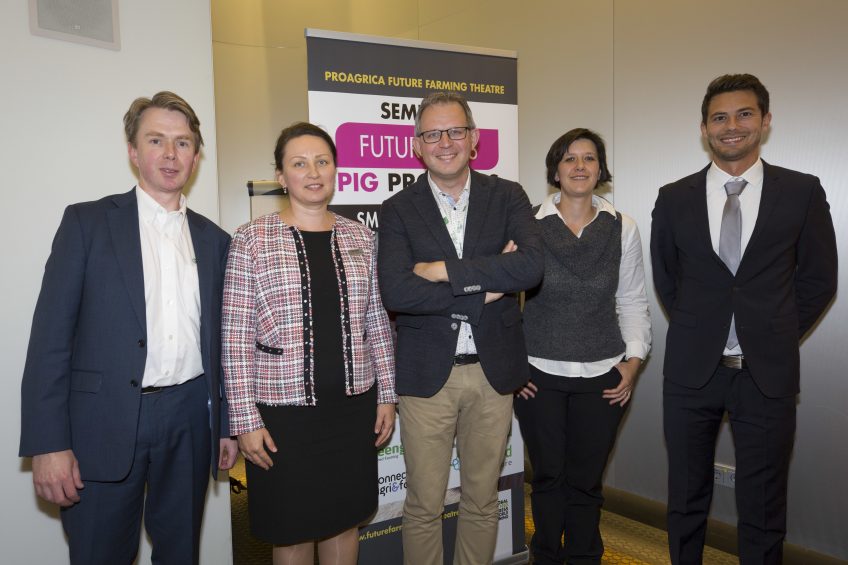Smart farming pig seminar showcases new innovations

4 guest speakers showcased smart farming technology at the Proagrica Future Farming Theatre at the Global Forum for Innovations in Agriculture, held in conjunction with VIV Europe in Utrecht, the Netherlands.
What separates smart farmers from the rest?
There’s no shortage of innovative tools that detect and gather on-farm data. Having access to so much information, however, can leave farmers feeling overwhelmed. What separates smart farmers from the rest is the fact that they don’t simply collect data. Smart farmers learn how to use the data they collect to improve production, animal health and welfare.
Smart farming and mycotoxins:
Mycotoxin prediction tools
One of the big risks pig farmers face today is the risk of mycotoxocosis from contaminated feed. In livestock production, pigs are the most sensitive animals to mycotoxin contamination. Olga Averkieva, business development manager at Nutriad, Belgium, explained the risk, offered insight into the available prediction tools, and informed visitors about MycoMan, a smartphone application that helps producers manage the negative effects of moulds and mycotoxins.
Early mycotoxin detection tools
The problem with mycotoxins, said Ms Averkieva, is that most acute cases cannot be detected, except in the case of zearalenone. The biggest mycotoxin-related losses come from subclinical cases. Early detection tools and preventative measures can help lower that risk, though, she said.
Contributing factors to mycotoxin formation in the field
- Delayed harvest,
- Drought stress
- Rains during crop growth
Early mycotoxin detection tools include mycotoxin prediction models like:
- Weather outlooks
- Mycotoxin surveys in harvested grain.
The problem with pre-harvest models is that they only provide 30–50% certainty, said Ms Averkieva. Screening grains during harvest should support pre-harvest models.
Rapid test for mycotoxin detection
Ms Averkieva pointed to 2 rapid tests for mycotoxin detection.
 The first is from Charm Sciences and analyses of 6 mycotoxins:
The first is from Charm Sciences and analyses of 6 mycotoxins:- Aflatoxins
- Deoxynivalenol
- Zearalenone
- Fumonisins
- T-2/HT-2 toxin
- Ochratoxin A
 Is a rapid test from R-Biopharm. Ms Averkieva said it is the most portable and user-friendly rapid test on the market today. It analyses the same mycotoxins as Charm Sciences except for ochratoxin A. The second test is most suitable for farmers, she said.
Is a rapid test from R-Biopharm. Ms Averkieva said it is the most portable and user-friendly rapid test on the market today. It analyses the same mycotoxins as Charm Sciences except for ochratoxin A. The second test is most suitable for farmers, she said.
How to take samples for mycotoxin detection
Since mycotoxins are not equally distributed in grain, the best procedure is to take several samples from varying locations. “A larger sample increases the chances of finding mycotoxins, especially in a large quantity of material,” said Ms Averkieva.
What to do with sampling data
Perhaps more important than collecting sample data is knowing what to do with that collected information afterwards. Ms Averkieva provided an interesting example to elucidate this. A maize survey reveals 2,000 ppb DON. The grain supplier can assure the pig producer that the risk of contamination is small, since current legislation for DON in grains for animals is 8,000 ppb. The pig producer, she explained, goes on to use 50% maize in the pig diet (so 1,000 ppb DON), but EU authorities recommend a maximum of 900 ppb DON in pig feed.
“Question conclusions and study levels yourself”
Ms Averkieva urged the importance of questioning the sampling conclusions. To aid in the evaluation and interpretation of results, Nutriad now offers a smartphone application called MycoMan. The app helps farmers to assess risk and offers a recommended dose of mycotoxin deactivator or binder. App installation is free.
Smart farming and pig health:
Keeping track of medical treatments
There are so many different ways to track data on a pig barn. Medical treatments and vaccinations, are however, still recorded by hand. “There is no modern technology for the digital monitoring of medical treatments so far,” said Jonas Riess, product manager at Henke-Sass in Germany, during his talk.
There has been much discussion on the use and misuse of antibiotics in recent years. Consumers want more transparency in terms of what animals have eaten, how they have lived and what antibiotics they have been given. As a result, farmers face increased legislation. Farmers have to be able to show they know when the treatment was performed, on what date and at what time. They have to know which animal was injected with which treatment and at what dose. They also need to know where the treatment was carried out and who administered it.

“We see that there is clearly a need to measure and track and trace, and report and analyse medical treatments, and to make this information available for all internal and external stakeholders in a very simple and very safe way,” said Mr Riess.
Recording injection information quickly & accurately
The Henke-Sass solution to all of these questions is V-ETIC, a solution for recording injection information quickly and accurately. V-ETIC works with low-frequency RFID ear tags. It allows farmers to collect, store, share and utilise injection information wherever, whenever. Lightweight and battery powered, the device is connected via Bluetooth, has 10 hours of working time and stores up to 130,000 records.
Sensor technology to improve pig health
Keeping track of medical information isn’t the only way to improve pig health on the farm. The next 2 speakers focused on sensor technology used to detect everything from air quality to temperature, water consumption and disease.
Angela van der Sanden of Connecting Agri and Food in the Netherlands, for instance, presented ‘Slimme Stal’ – a sensor that provides a real-time, online view of the barn. The sensor tracks temperature, carbon dioxide levels, water consumption, air pressure, ammonia, hydrogen sulfide and butyric acid.

Ms van der Sanden said technology like this is made possible because of LoRaWAN (long range wide area network), which provides the infrastructure for a secure, shared networks of low-cost wireless sensors that report on data such as soil moisture, rainfall data, livestock data and crop health. The sensor box, she said, goes to the LoRa Gateway devise, which then goes to the wired internet and collected in a data centre in Frankfurt. She said having access to long-term data could help detect issues, like disease outbreaks.
Measuring sound in the barn
Connecting Agri and Food not only monitors data, but also conducts analysis and offers benchmarks. In the future, Ms van der Sanden said they plan to use technology to measure sound in the barn with the hopes that it will tell them about animal health and welfare.
Smart farming and pig production:
Sensor technology to improve pig production
Greengage, a lighting company based in the UK, is looking to sensor technology to improve pig production as well. While lighting plays a role in pig health – red light, for instance, can reduce aggression in pigs – it also makes for the perfect conduit for sensor technology, explained Steven Mitchell, marketing manager for Greengage.

“We’re launching sensors that clip onto the existing cabling which monitor heat, humidity, CO2 and ammonia,” said Mr Mitchell. “We’re also using a thermal imaging camera, which is important for disease detection in pigs.”
In the future, the company is looking to work with blockchain technology as well. “I think it’s going to be really important for agriculture to get more involved in it,” said Mr Mitchell.
All of this technology, he said in conclusion, will make swine farming easier, smarter and greener.












